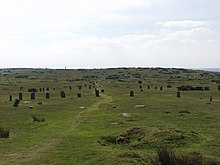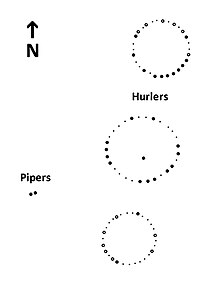The Hurlers (stone circles): Difference between revisions
m sp |
Added a more detailed account of the location, legend, and structure of the circles, pulling in some stuff from the German version of this page |
||
| Line 1: | Line 1: | ||
{{coord|50.5142|-4.4547|display=title}} |
{{coord|50.5142|-4.4547|display=title}} |
||
[[ |
[[File:Hurlers.jpg|right|thumb|The Hurlers]] |
||
[[File:Hurlers1.jpg|right|thumb|The north circle]] |
|||
[[File:Hurlers3.jpg|right|thumb|Map of the stone circles]] |
|||
[[File:Hurlers2.jpg|right|thumb|Standing stones in the middle circle]] |
|||
'''The Hurlers''' ([[Cornish Language|Cornish]]: ''Hr Carwynnen'') |
'''The Hurlers''' ([[Cornish Language|Cornish]]: ''Hr Carwynnen'') are a group of three [[stone circle]]s in [[Cornwall]], England, UK. The site is half-a-mile (0.8 km) west of the village of [[Minions, Cornwall|Minions]] on the eastern flank of [[Bodmin Moor]], and approximately four miles (6 km) north of [[Liskeard]]<ref>Ordnance Survey: Landranger map sheet 201 ''Plymouth & Launceston'' ISBN 978-0-319-23146-3</ref> at {{gbmapping|SX 258 714}}. |
||
==Location== |
|||
Just to the west of the circles are two standing stones known as 'The Pipers'. |
|||
The Hurlers are in the [[Caradon]] district north of [[Liskeard]] in the village of [[Minions, Cornwall|Minions]] on the southern edge of [[Bodmin Moor]] in [[Cornwall]]. Just to the west of the circles are two standing stones known as The Pipers. Nearby is [[Rillaton Barrow]] and [[Trethevy Quoit]], an [[entrance grave]] from the [[Neolithic]] period. The Hurlers are managed by the [[Cornwall Heritage Trust]] on behalf of [[English Heritage]].<ref>[http://www.cornwallheritagetrust.org/sites/ Sites Managed and Cared for by Cornwall Heritage Trust for English Heritage]</ref> |
|||
==Origin of the name== |
|||
The name "The Hurlers" derives from a legend, in which men were playing [[Cornish hurling]] on a [[Sunday]] and were magically transformed into stones as a punishment.<ref name="Westwood">Westwood, Jennifer (1985), ''Albion. A Guide to Legendary Britain''. London : Grafton Books. ISBN 0-246-11789-3. p. 21.</ref> The two "Pipers" are supposed to be the figures of two men who played tunes on a Sunday and suffered the same fate.<ref name="engher">[http://www.english-heritage.org.uk/daysout/properties/hurlers-stone-circles/history-and-research/ The Hurlers Stone Circles: History and Research], English Heritage</ref> According to another legend, it is impossible to accurately count the exact number of standing stones.<ref>[http://www.stone-circles.org.uk/stone/hurlers.htm ''The Hurlers''], www.stone-circles.org.uk</ref> |
|||
==Construction== |
|||
| ⚫ | |||
The three stone circles of the Hurlers, which lie approximately on a line from SSW to NNE, have diameters of 35, 42 and 33 m. The two outer stone circles are circular, the middle and largest stone circle, however, is slightly elliptical. The southern stone circle has survived the least well, and now contains only nine stones, two of which are upright and the other seven are partially covered with soil.<ref name="engher"/> In the middle circle 14 stones survive from an original 28.<ref name="engher"/> The stones show clear traces of being hammered smooth.<ref name="engher"/> The northern stone circle contained around 30 standing stones, from which 15 are still visible.<ref name="engher"/> Two other monoliths, The Pipers, are 100 m southwest of the center circle. They may have been entrance stones to the Hurlers.<ref name="historiccornwall">[http://www.historic-cornwall.org.uk/a2m/bronze_age/stone_circle/hurlers/hurlers.htm www.historic-cornwall.org.uk]</ref> |
|||
==Early accounts== |
|||
The earliest mention of the Hurlers was by historian [[John Norden]], who visited them around 1584.<ref name="vch">M. V. Taylor, Francis Haverfield, Louis Francis Salzman, 1906, ''The Victoria history of the county of Cornwall: Volume 1'', page 399</ref> They were also described by [[William Camden]] in his ''Britannia'' of 1586.<ref name="vch"/> In 1754 [[William Borlase]] published the first detailed description of the site.<ref>William Borlase, ''Antiquities Historical and Monumental of the County of Cornwall'', Bowyer and Nichols, London</ref> |
|||
==Excavations== |
|||
The circles were first noted by historian [[John Norden]] in 1584 and the first detailed description was made by [[William Borlase]] in 1754. The tradition states that they are men turned to stone for profaning the [[Lord's Day]] by taking part in a [[Cornish hurling]] match; the arrangement of the stones led to the name.<ref name="Westwood">Westwood, Jennifer (1985), ''Albion. A Guide to Legendary Britain''. London : Grafton Books. ISBN 0-246-11789-3. p. 21.</ref> |
|||
| ⚫ | C. A. Ralegh-Radford excavated the site in the 1930s, and he also partly restored the two northern circles by re-erecting some stones and placing marker stones in the positions of those missing <ref>R. Radford 1939 Proceedings of the Prehistoric Society</ref><ref>[http://www.cornisharchaeology.org.uk/index_htm_files/CAS123.pdf cornisharchaeology.org]</ref>. The archives from the unpublished excavation reports have been re-evaluated by Jacky Nowakowski (Cornwall Heritage Trust) and John Gould (English Heritage) and this may result in more analysis and publication.<ref>Cornwall Archaeology newlsetter no: 123, June 2010</ref> |
||
| ⚫ | There have been several subsequent investigations of the area. Between 1975-1985 aerial survey and subsequent analysis by various teams, (including thise from [[Cambridge University]], [[University College London]], [[RCHME]] and co-ordinated by Cornwall Archaeology Unit) was used to identify and map the features <ref>[http://www.english-heritage.org.uk/publications/bodmin-moor-archaeological-survey-vol-1/ Bodmin Moor: An archaeological survey - Volume 1]</ref>. English Heritage conducted a geophysical survey in 2004. A survey by the Cornwall Archeological Unit in 2009 indicated that there might be a fourth circle present, together with two stone rows.<ref>Cornwall County Council, Cornwall Archaeological Unit Nowakowski J, Gould J, Gossip J & Buck C/2010/The Hurlers, Cornwall: archaeological assessment and scoping study 2009/Report No 09R062 </ref> |
||
| ⚫ | |||
| ⚫ | C. A. Ralegh-Radford excavated the site in the 1930s, and he also partly restored the two northern circles by re-erecting some stones and placing marker stones in the positions of those missing <ref>R. Radford 1939 Proceedings of the Prehistoric |
||
| ⚫ | There have been several subsequent investigations of the area. Between 1975-1985 aerial survey and subsequent analysis by various teams, (including thise from [[Cambridge University]], [[University College London]], [[RCHME]] and co-ordinated by Cornwall Archaeology Unit) was used to identify and map the features <ref>http://www.english-heritage.org.uk/publications/bodmin-moor-archaeological-survey-vol-1/</ref>. English Heritage conducted a geophysical survey in 2004. A survey by the Cornwall Archeological Unit in 2009 indicated that there might be a fourth circle present, together with two stone rows.<ref>Cornwall County Council, Cornwall Archaeological Unit Nowakowski J, Gould J, Gossip J & Buck C/2010/The Hurlers, Cornwall: archaeological assessment and scoping study 2009/Report No 09R062 </ref> |
||
In 1999 there was some controversy regarding this site and others under the care of the [[English Heritage]] organisation. Members of a pressure group, the [[Revived Cornish Stannary Parliament#Operation_Chough|Revived Cornish Stannary Parliament]], removed several signs bearing the English Heritage name.<ref>[http://www.cornishstannaryparliament.co.uk/heritage-signs.html Cornish Stannary Parliament tackles English cultural aggression in Cornwall.]</ref><ref>[http://news.bbc.co.uk/1/hi/england/1768853.stm BBC News: Historic signs case trio bound over]</ref> |
|||
Since this action, several of the smaller sites including this one, [[Dupath Well]], [[Tregiffian Burial Chamber]], [[St Breock Downs Monolith]], [[King Doniert's Stone]], [[Trethevy Quoit]] and [[Carn Euny]], have been transferred to the management of the Cornwall Heritage Trust.<ref>[http://www.cornwallheritagetrust.org/] Cornwall Heritage Trust website</ref> |
|||
"The Hurlers" are the subject of a 2008 song by Devon singer [[Seth Lakeman]]. |
|||
== See also == |
|||
*[[Cornish hurling]] |
|||
== References == |
== References == |
||
{{reflist}} |
{{reflist}} |
||
==Further reading== |
|||
* John Barnatt, ''Prehistoric Cornwall, The Ceremonial Monuments'', 1982 (ISBN 0-85500-129-1) |
* John Barnatt, ''Prehistoric Cornwall, The Ceremonial Monuments'', 1982 (ISBN 0-85500-129-1) |
||
Revision as of 21:25, 24 May 2011
50°30′51″N 4°27′17″W / 50.5142°N 4.4547°W




The Hurlers (Cornish: Hr Carwynnen) are a group of three stone circles in Cornwall, England, UK. The site is half-a-mile (0.8 km) west of the village of Minions on the eastern flank of Bodmin Moor, and approximately four miles (6 km) north of Liskeard[1] at grid reference SX 258 714.
Location
The Hurlers are in the Caradon district north of Liskeard in the village of Minions on the southern edge of Bodmin Moor in Cornwall. Just to the west of the circles are two standing stones known as The Pipers. Nearby is Rillaton Barrow and Trethevy Quoit, an entrance grave from the Neolithic period. The Hurlers are managed by the Cornwall Heritage Trust on behalf of English Heritage.[2]
Origin of the name
The name "The Hurlers" derives from a legend, in which men were playing Cornish hurling on a Sunday and were magically transformed into stones as a punishment.[3] The two "Pipers" are supposed to be the figures of two men who played tunes on a Sunday and suffered the same fate.[4] According to another legend, it is impossible to accurately count the exact number of standing stones.[5]
Construction
The three stone circles of the Hurlers, which lie approximately on a line from SSW to NNE, have diameters of 35, 42 and 33 m. The two outer stone circles are circular, the middle and largest stone circle, however, is slightly elliptical. The southern stone circle has survived the least well, and now contains only nine stones, two of which are upright and the other seven are partially covered with soil.[4] In the middle circle 14 stones survive from an original 28.[4] The stones show clear traces of being hammered smooth.[4] The northern stone circle contained around 30 standing stones, from which 15 are still visible.[4] Two other monoliths, The Pipers, are 100 m southwest of the center circle. They may have been entrance stones to the Hurlers.[6]
Early accounts
The earliest mention of the Hurlers was by historian John Norden, who visited them around 1584.[7] They were also described by William Camden in his Britannia of 1586.[7] In 1754 William Borlase published the first detailed description of the site.[8]
Excavations
C. A. Ralegh-Radford excavated the site in the 1930s, and he also partly restored the two northern circles by re-erecting some stones and placing marker stones in the positions of those missing [9][10]. The archives from the unpublished excavation reports have been re-evaluated by Jacky Nowakowski (Cornwall Heritage Trust) and John Gould (English Heritage) and this may result in more analysis and publication.[11]
There have been several subsequent investigations of the area. Between 1975-1985 aerial survey and subsequent analysis by various teams, (including thise from Cambridge University, University College London, RCHME and co-ordinated by Cornwall Archaeology Unit) was used to identify and map the features [12]. English Heritage conducted a geophysical survey in 2004. A survey by the Cornwall Archeological Unit in 2009 indicated that there might be a fourth circle present, together with two stone rows.[13]
The Hurlers were scheduled as an ancient monument in 1929, and the protected area was extended in 1994 to include The Pipers.[14]
References
- ^ Ordnance Survey: Landranger map sheet 201 Plymouth & Launceston ISBN 978-0-319-23146-3
- ^ Sites Managed and Cared for by Cornwall Heritage Trust for English Heritage
- ^ Westwood, Jennifer (1985), Albion. A Guide to Legendary Britain. London : Grafton Books. ISBN 0-246-11789-3. p. 21.
- ^ a b c d e The Hurlers Stone Circles: History and Research, English Heritage
- ^ The Hurlers, www.stone-circles.org.uk
- ^ www.historic-cornwall.org.uk
- ^ a b M. V. Taylor, Francis Haverfield, Louis Francis Salzman, 1906, The Victoria history of the county of Cornwall: Volume 1, page 399
- ^ William Borlase, Antiquities Historical and Monumental of the County of Cornwall, Bowyer and Nichols, London
- ^ R. Radford 1939 Proceedings of the Prehistoric Society
- ^ cornisharchaeology.org
- ^ Cornwall Archaeology newlsetter no: 123, June 2010
- ^ Bodmin Moor: An archaeological survey - Volume 1
- ^ Cornwall County Council, Cornwall Archaeological Unit Nowakowski J, Gould J, Gossip J & Buck C/2010/The Hurlers, Cornwall: archaeological assessment and scoping study 2009/Report No 09R062
- ^ Heritagegateway.org.uk Corwall and Scilly HER records
Further reading
- John Barnatt, Prehistoric Cornwall, The Ceremonial Monuments, 1982 (ISBN 0-85500-129-1)
External Links
